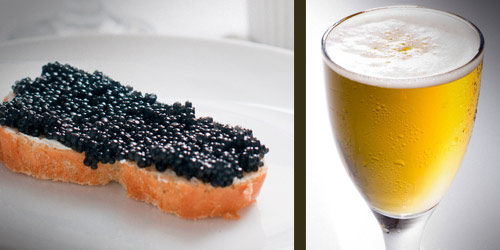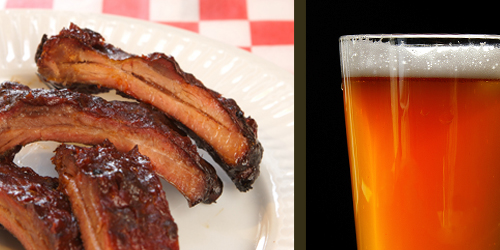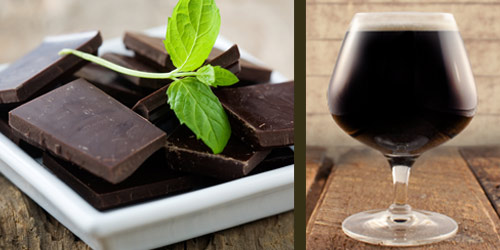Just as there are standard foods that pair well together—peanut butter and jelly, eggs and bacon, steak and potatoes—certain foods and beverages are destined to be paired together. Although there are really no wrong or right pairings in the eye of the beholder, some have definitely proven to be better and have become standard partners.
The Three Beverage and Food Pairing Experiences
- The pairing is mismatched. Both the flavors of the beverage and the food are lost, if not destroyed. This is rare, but if you want to experience it, try eating hot wings with a really tannic red wine. Not pretty.
- Middle of the road pairings. Either the beverage or the food is the star, while the other plays a supporting role that is often overshadowed.
- Pairing epiphanies. The pairings that enhance and heighten each other to a level of euphoria. The pairings that drive you to take another bite, and then another sip; you never want the experience to end. These are the moments when you realize that you may never be able to eat that dish without that drink ever again.
Sadly, many people have been trained to think that certain foods belong only with certain beverages. Well folks, I’m here to tell you that these classic pairings—most often recognized in the wine world—are amazing, but craft beer can be just as extraordinary. But don’t just take my word for it…
Below, some of the country’s most renowned beer and food experts have joined forces to breakdown the best craft beer counter-pairings for eight of the most classic wine and food combinations. These pairings are sure to make you think twice before you reach for a glass of wine with your meal!
Eight Craft Beer Counter-Pairings for Classic Wine Pairings
Caviar
Classic Wine Pairing: Champagne Craft Beer Alternative: Belgian Strong Golden Ale or Tripel Commercial Examples: Victory Golden Monkey, Ommegang Tripel Perfection, New Belgium Trippel, North Coast Pranqster, Russian River Damnation Industry Expert: Ray Daniels, Director, Cicerone® Certification Program “Fine Sturgeon caviar has a delicate salmon-like flavor that requires the finesse that comes with a highly-carbonated Strong Golden Ale. The water cracker-like malt flavor, peppery phenols, and minerally dryness cleanse the palate of the caviar richness while hooking into its earthiness. The touch of honey sweetness will balance the residual saltiness and leave you wishing for another bite and sip—if you can afford it!” |
|
|
Oysters
Classic Wine Pairing: Chablis Craft Beer Alternative: Dry Stout Commercial Examples: Moylan’s Dragoons Irish Dry Stout, Sprecher Brewing Irish Style Stout, Bison Brewing Chocolate Stout Industry Expert: Lew Bryson, beer writer and author of the blog Seen Through a Glass “It may seem counter-intuitive, given the difference in character and appearance between dark beer and pale wine, but the dry bitterness and slightly smoky touch of the Stout works perfectly with the sweet, brine touch of a fresh-shucked oyster. It works well with fried oysters in a po’ boy, too!” |
|
|
Lobster
Classic Wine Pairing: Chardonnay Craft Beer Alternative: Flanders-style Red Ale or Grand Cru Commercial Examples: New Belgium La Folie, Lost Abbey Red Poppy, The Bruery Oude Tart Industry Expert: Bill Sysak, Beverage Supervisor and Certified Cicerone® at Stone Brewing World Bistro & Gardens “Grand Cru and lobster are a match made in heaven! This style of beer has a pleasing tartness on first sip that cuts through the richness of the lobster meat, the carbonation from this style allows your palate to be refreshed for the next bite. The next sip accentuates the lobsters succulent sweet nature. The beer has wonderful acetic notes that precludes the use of lemon with your lobster. The shellfish also elevates the beer bringing out wonderful fruit characteristics of black cherries, passion fruit, and currants with an intense vinous finish. Vinous you say, red wine with shellfish, unheard of! Not so with beer!” |
|
|
Duck
Classic Wine Pairing: Pinot Noir Craft Beer Alternative: Belgian Dubbel Commercial Examples: Ommegang Abbey Ale, Allagash Dubbel Ale, Goose Island Pere Jacques, Sierra Nevada Ovila Abbey Dubbel, Lost Abbey Lost & Found Industry Expert: Jared Rouben, Brewmaster of the Goose Island brewpubs “Belgian Dubbels have wonderful dried cherry and plum flavors and aromatics that pair so well with duck. Regardless of how the duck is prepared the Dubbel has layers of flavor to compliment the richness of duck. I am thinking Sun Wah’s Peking duck with pickled vegetables , sweet hoisin sauce, in a warm dumpling bun with our “Bitter Love” a Belgian Dubbel with brandied cherries, burnt orange peel, and shaved cinnamon.” |
|
|
Steak
Classic Wine Pairing: Cabernet Sauvignon Craft Beer Alternative: Black Lager, Dry Stout or “Black IPA” Commercial Examples: Black Lager: Full Sail Session Black Lager, Moonlight Brewing Death & Taxes, Stone Sublimely Self-Righteous Ale, Deschutes Hop in the Dark, Odell Brewing Mountain Standard Industry Expert: Sayre Piotrkowski, Certified Cicerone®, Restaurant Consultant and Editor at BeerAndSoul.com “When pairing a steak dish, I almost always reach for something dark and dry. Beyond that, cuts of beef can vary drastically in fat and iron content. Also, the cooking method you select will influence the pairing as well. If you are grilling, a bit of smoked-malt to the beer’s grist can really make things light up. A grilled flat-iron steak will work wonders with a Rauchbier, especially if a bit of the beer finds its way into whatever you’ve concocted to brush and/or marinate the meat with. For a more delicate pan-seared filet mignon, I might reach for a simple, clean-finishing Dry Stout or even an ultra-contemporary Black IPA/CDA. Dark and hoppy beers can really work wonders with a well-marbled cut of beef. I find the Black IPA especially useful with more expressive sauces like Au Poivre or a reduction.” |
|
|
Lamb
Classic Wine Pairing: Bordeaux Craft Beer Alternative: Robust Porter/ Smoked Porter Commercial Examples: Anchor Porter, Bell’s Porter, Great Lakes Edmund Fitzgerald Porter, Alaskan Smoked Porter, Stone Smoked Porter, Yazoo Sue Industry Expert: Ashley Routson, Founder of DrinkWithTheWench.com and BeerMixology.com “Most commonly described as gamey, lamb is an acquired taste for many people. Its rich and earthy flavors demand an equally robust and rustic beer pairing. The dark roasty and lightly burnt malt flavors in a Porter heighten the earthiness and gaminess of the lamb, while its dry, roasty finish and moderate carbonation cut through the fat, acting as a perfect palate cleanser. When it comes to grilled lamb dishes, the smoke and char flavors in Smoked Porters really make the pairing pop.” |
|
|
Barbecue
Classic Wine Pairing: Rosé and Zinfandel Craft Beer Alternative: Saison, Double IPA & Black IPA Commercial Examples: Saison: New Holland Golden Cap, Jolly Pumpkin Bam Biere, Boulevard Tank 7, The Bruery Saison Rue, Lost Abbey Red Barn; Double IPA: Firestone Walker Double Jack, Russian River Pliny the Elder, Founder’s Double Trouble, Dogfish Head 90 Minute; Black IPA: See Steak Industry Expert: Lucy Saunders, author of Grilling with Beer and culinary/craft beer instructor at the Siebel Institute “Now in the world of wine, a fruity white zinfandel or rosé is typically recommended for barbecue or grilled foods. But I’m a fan of fresh beer. A lighter Saison or unfiltered Farmhouse Ale with a spicy, yeasty edge goes well with pulled pork or grilled chicken—refreshing but not overly malty and sweet. For brisket with a lemon-garlic-pepper rub, I’d choose a double IPA, with resinous hop character to enhance the peppery heat and cut through the smoke.” |
|
|
Dark Chocolate |
 Ashley V. Routson, known amongst the craft beer community as The Beer Wench, is a self-proclaimed craft beer evangelist and social media puppeteer on a mission to advance the craft beer industry through education, inspiration and advocacy. When she is not preoccupied with the craft beer revolution or her addiction to the Internet, Ashley enjoys cooking, artisan spirits, boutique wines, fine cigars, and college football (she bleeds Scarlet and Gray for The Ohio State University). You can find her musings at Drink With The Wench.
Ashley V. Routson, known amongst the craft beer community as The Beer Wench, is a self-proclaimed craft beer evangelist and social media puppeteer on a mission to advance the craft beer industry through education, inspiration and advocacy. When she is not preoccupied with the craft beer revolution or her addiction to the Internet, Ashley enjoys cooking, artisan spirits, boutique wines, fine cigars, and college football (she bleeds Scarlet and Gray for The Ohio State University). You can find her musings at Drink With The Wench.
CraftBeer.com is fully dedicated to small and independent U.S. breweries. We are published by the Brewers Association, the not-for-profit trade group dedicated to promoting and protecting America’s small and independent craft brewers. Stories and opinions shared on CraftBeer.com do not imply endorsement by or positions taken by the Brewers Association or its members.


Share Post